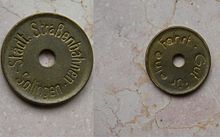Money substitutes

Money substitutes or money surrogates are all means of payment in payment transactions that do not belong to the legal tender .
General
Only legal tender subject in the case of monetary obligations, a compulsory acceptance by the creditors . If a debtor wants to settle his debts with legal tender, his creditor is obliged to accept what leads to the fulfillment of the debt. In the case of money surrogates, there is no compulsion to accept on the part of the obligee, nor is there immediate fulfillment in the case of acceptance by the obligee. If the creditor refuses to accept a monetary substitute, the debtor's monetary debt is not extinguished and he must settle it with legal tender. The money surrogates under securities law - checks, credit cards and travelers checks - are therefore not money.
history
For Jacques Necker in 1790, money surrogates were a symbol of value, "which one puts next to money, into which it can be transformed with little effort". Money surrogates have been studied in particular in economics . The banking theory ( John Stuart Mill , John Fullarton , Thomas Tooke ) also included money surrogates such as trade bills and credits in the monetary quantities that are decisive for the price level . In contrast to this, the money surrogates were strictly proportional to the amount of money in the currency theory ( David Ricardo ) and had no independent meaning for the price level.
For Adolph Wagner in 1867 money surrogates “only had the tendency to displace money from its function as a means of circulation, but they want it to exist as a price measure.” Georg Simmel recognized the advantage of cashless payments as early as 1900: “By those money surrogates (checks, bills of exchange, giro) take the place of cash payments, they save the individual from having to keep a large amount of money in his or her cash register ... ”For Ludwig von Mises in 1912 the money surrogates were“ immediately due, secure claims ”. These included a bank issued notes, token coins and demand deposits in a bank by the issuer at the request against cash were to exchange. In modern economics, it is not only the amount of money that is decisive for the sales opportunities in an economy, but also the money surrogates, which, like money, serve as means of payment.
species
Money surrogates are so-called auxiliary means of payment that can be used by the debtor as a means of payment instead of cash. In the past, this included travelers checks and checks , today credit cards , prepaid cards or other payment cards and bills of exchange , in a broader sense also tokens , postage stamps , vouchers , promissory notes or letters of credit , provided they are in circulation as an independent means of payment. It is therefore a prerequisite that these papers certifying a claim to money are in circulation as a means of payment. The circulation begins with the issuing contract and the associated handover of the certificate from the issuer to the next owner .
Mode of action
If the creditor accepts a check issued by his debtor on account of payment, the creditor must first submit this check to his bank for crediting the account . However, the bank only credits the check to the creditor “ reserved for receipt ”. This provisional credit will not become final (and available to the obligee) until the crediting bank has received notice of the check from the debtor's bank. Only with the final account credit is the obligation fulfilled . In contrast to the legal tender, several steps are required with the money surrogate before fulfillment occurs; if the check is not cashed, its function as a money surrogate has even failed.
See also
Individual evidence
- ↑ Julius von Staudinger / Dieter Medicus , Comment BGB , 1983, p. 32
- ↑ Jacques Necker, Reflections on the Origin, Nature and Administration of National Wealth , 1790, p. 101
- ^ Adolph Wagner, Contributions to the Doctrine of Banks , 1867, p. 36
- ↑ Georg Simmel, The Philosophy of Money, 1900, p. 169
- ↑ Ludwig von Mises, Theory of Money and Circulation Means , 1912, p. 31
- ↑ Manfred Borchert, Money and Credit: Introduction to Monetary Theory and Monetary Policy , 2003, p. 90
- ↑ Reinhold Adrian, Der Bankbetrieb , 2000, p. 114